#Salmon in River
Explore tagged Tumblr posts
Video
Searching for Salmon in the Brooks River (Katmai National Park & Preserve) by Mark Stevens Via Flickr: One can see the red hints in the river waters of sockeye salmon.
#Alaska 2019#Alaska Peninsula Brown Bear#Alaska Peninsula Ranges#Alaska-Yukon Ranges#Aleutian Ranges#Azimuth 48#Bear in Water#Brooks Camp#Brooks River#Brown Bear#Day 13#DxO PhotoLab 3 Edited#Falls Platform#Image Capture With Arsenal#Katmai#Katmai National Park & Preserve#Katmai National Park and Preserve#Landscape#Landscape - Scenery#Looking NE#Looking NNE#Nature#Nikon D800E#No People#Outside#Peninsular Grizzly#Project365#River#Salmon in River#Scenics - Nature
31 notes
·
View notes
Video
Searching for Salmon in the Brooks River (Katmai National Park & Preserve) by Mark Stevens Via Flickr: One can see the red hints in the river waters of sockeye salmon.
#Alaska 2019#Alaska Peninsula Brown Bear#Alaska Peninsula Ranges#Alaska-Yukon Ranges#Aleutian Ranges#Azimuth 48#Bear in Water#Brooks Camp#Brooks River#Brown Bear#Day 13#DxO PhotoLab 3 Edited#Falls Platform#Image Capture With Arsenal#Katmai#Katmai National Park & Preserve#Katmai National Park and Preserve#Landscape#Landscape - Scenery#Looking NE#Looking NNE#Nature#Nikon D800E#No People#Outside#Peninsular Grizzly#Project365#River#Salmon in River#Scenics - Nature
2 notes
·
View notes
Text
"For years, California was slated to undertake the world’s largest dam removal project in order to free the Klamath River to flow as it had done for thousands of years.
Now, as the project nears completion, imagery is percolating out of Klamath showing the waterway’s dramatic transformation, and they are breathtaking to behold.
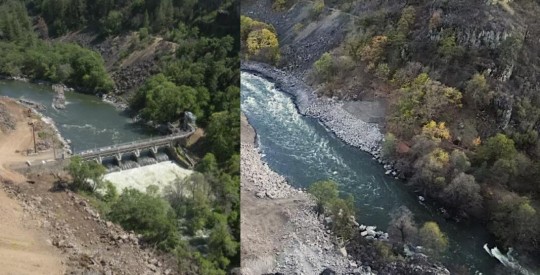
Pictured: Klamath River flows freely, after Copco-2 dam was removed in California.
Incredibly, the project has been nearly completed on schedule and under budget, and recently concluded with the removal of two dams, Iron Gate and Copco 1. Small “cofferdams” which helped divert water for the main dams’ construction, still need to be removed.
The river, along which salmon and trout had migrated and bred for centuries, can flow freely between Lake Ewauna in Klamath Falls, Oregon, to the Pacific Ocean for the first time since the dams were constructed between 1903 and 1962.
“This is a monumental achievement—not just for the Klamath River but for our entire state, nation, and planet,” Governor Gavin Newsom said in a statement. “By taking down these outdated dams, we are giving salmon and other species a chance to thrive once again, while also restoring an essential lifeline for tribal communities who have long depended on the health of the river.”
“We had a really incredible moment to share with tribes as we watched the final cofferdams be broken,” Ren Brownell, Klamath River Renewal Corp. public information officer, told SFGATE. “So we’ve officially returned the river to its historic channel at all the dam sites. But the work continues.”
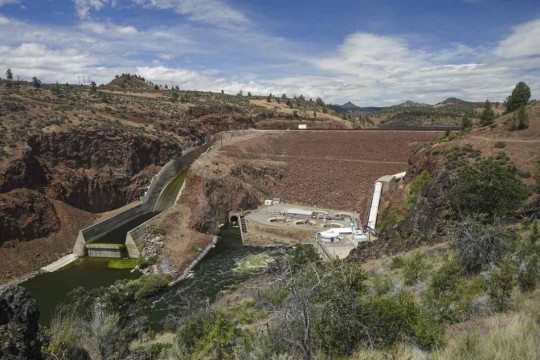
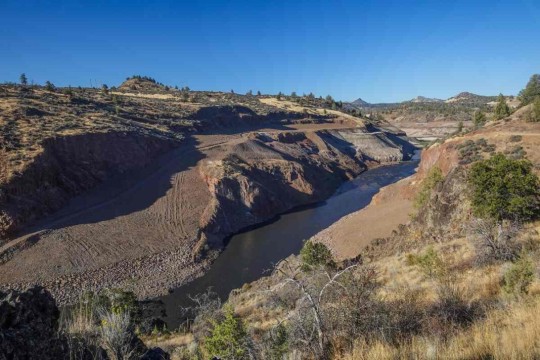
Pictured: Iron Gate Dam, before and after.
“The dams that have divided the basin are now gone and the river is free,” Frankie Myers, vice chairman of the Yurok Tribe, said in a tribal news release from late August. “Our sacred duty to our children, our ancestors, and for ourselves, is to take care of the river, and today’s events represent a fulfillment of that obligation.”
The Yurok Tribe has lived along the Klamath River forever, and it was they who led the decades-long campaign to dismantle the dams.
At first the water was turbid, brown, murky, and filled with dead algae—discharges from riverside sediment deposits and reservoir drainage. However, Brownell said the water quality will improve over a short time span as the river normalizes.
“I think in September, we may have some Chinook salmon and steelhead moseying upstream and checking things out for the first time in over 60 years,” said Bob Pagliuco, a marine habitat resource specialist at the National Oceanic and Atmospheric Administration in July.
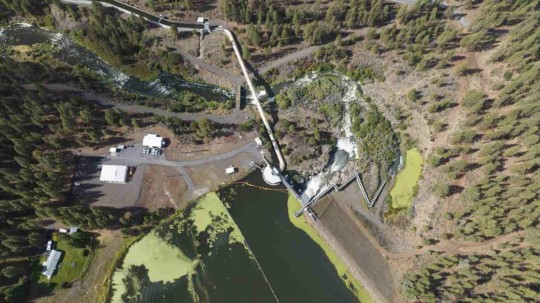

Pictured: JC Boyle Dam, before and after.
“Based on what I’ve seen and what I know these fish can do, I think they will start occupying these habitats immediately. There won’t be any great numbers at first, but within several generations—10 to 15 years—new populations will be established.”
Ironically, a news release from the NOAA states that the simplification of the Klamath River by way of the dams actually made it harder for salmon and steelhead to survive and adapt to climate change.
“When you simplify the habitat as we did with the dams, salmon can’t express the full range of their life-history diversity,” said NOAA Research Fisheries Biologist Tommy Williams.
“The Klamath watershed is very prone to disturbance. The environment throughout the historical range of Pacific salmon and steelhead is very dynamic. We have fires, floods, earthquakes, you name it. These fish not only deal with it well, it’s required for their survival by allowing the expression of the full range of their diversity. It challenges them. Through this, they develop this capacity to deal with environmental changes.”
-via Good News Network, October 9, 2024
#california#oregon#klamath river#dam#dam removal#yurok#first nations#indigenous activism#rivers#wildlife#biodiversity#salmon#rewilding#nature photography#ecosystems#good news#hope
6K notes
·
View notes
Text
If you aren't following the news here in the Pacific Northwest, this is a very, very big deal. Our native salmon numbers have been plummeting over the past century and change. First it was due to overfishing by commercial canneries, then the dams went in and slowed the rivers down and blocked the salmons' migratory paths. More recently climate change is warming the water even more than the slower river flows have, and salmon can easily die of overheating in temperatures we would consider comfortable.
Removing the dams will allow the Klamath River and its tributaries to return to their natural states, making them more hospitable to salmon and other native wildlife (the reservoirs created by the dams were full of non-native fish stocked there over the years.) Not only will this help the salmon thrive, but it makes the entire ecosystem in the region more resilient. The nutrients that salmon bring back from their years in the ocean, stored within their flesh and bones, works its way through the surrounding forest and can be traced in plants several miles from the river.
This is also a victory for the Yurok, Karuk, and other indigenous people who have relied on the Klamath for many generations. The salmon aren't just a crucial source of food, but also deeply ingrained in indigenous cultures. It's a small step toward righting one of the many wrongs that indigenous people in the Americas have suffered for centuries.
#salmon#dam removal#fish#animals#wildlife#dams#Klamath River#Klamath dams#restoration ecology#indigenous rights#Yurok Tribe#Karuk Tribe#nature#ecology#environment#conservation#PNW#Pacific Northwest
19K notes
·
View notes
Text
Excerpt from this story from Smithsonian Magazine:
For the first time in 112 years, Chinook salmon are swimming freely in the Klamath Basin in Oregon.
On October 16, biologists with the Oregon Department of Fish and Wildlife (ODFW) spotted the fish above the former site of the J.C. Boyle Dam in the Upper Klamath River. The dam was one of four that had blocked the salmon’s migration between the Klamath Basin and the Pacific Ocean. Each of those dams was recently deconstructed in the largest dam removal project in United States history, which has restored the river to its natural, free-flowing state.
At first, biologists wondered if they had really sighted a salmon. “We saw a large fish the day before rise to surface in the Klamath river, but we only saw a dorsal fin,” says Mark Hereford, leader of ODFW’s Klamath Fisheries Reintroduction Project, in a statement. “I thought, was that a salmon, or maybe it was a very large rainbow trout?”
But when the team returned on October 16 and 17, they were able to confirm the fall-run Chinook—making them the first to spot the species in the region since 1912.
The return of the salmon comes less than two months after the end of the dam removals in California and Oregon, an effort that took decades of advocacy by the surrounding tribes—including the Yurok, Karuk, Shasta, Klamath and Hoopa Valley, among others—whose people have deep ties to the Chinook salmon.
Ron Reed, a Karuk tribe member and traditional fisherman, participated in the campaigns for dam removal, advocating that the river’s restoration would help salmon recover. He isn’t surprised the fish have returned so quickly to their ancestral waters, he tells the Los Angeles Times’ Ian James.
“The fact that the fish are going up above the dams now, to the most prolific spawning and rearing habitat in North America, it definitely shines a very bright light on the future,” Reed tells the Los Angeles Times. “Because with those dams in place, we were looking at extinction. We were looking at dead fish.”
In one poignant case, tens of thousands of Chinook salmon died off in the span of days in 2002, as the water quality in the dammed Klamath River deteriorated from the lack of flow. The dams, built between the early 1900s and 1962, also contributed to algae blooms and diseases, and they blocked the salmon’s annual migration.
3K notes
·
View notes
Text

Chinook Salmon (Oncorhynchus tshawytscha)
#salmon#fish#chinook salmon#king salmon#hi im posting some fish pics because i think fish are beautiful#our rivers are full of fascinating elusive lil guys#or in this case fairly large guys#life cycle of the salmon
11K notes
·
View notes
Text
Only four months after dams blocking migration were removed, the first Chinook salmon traveled 230 miles to return to the Klamath River Basin. This was the first fish to come home to their ancestral migration routes since 1912.
Over 100 years shut out and it only took them four months to return home once they had the chance.
From the article:
“The return of our relatives the c’iyaal’s is overwhelming for our tribe. This is what our members worked for and believed in for so many decades,” said Roberta Frost, Klamath Tribes Secretary. “I want to honor that work and thank them for their persistence in the face of what felt like an unmovable obstacle. The salmon are just like our tribal people, and they know where home is and returned as soon as they were able[.]"

#hope#good news#dam removal#salmon conservation#river conservation#indigenous conservation#endangered species#environment#biodiversity#hopepunk#chinook salmon#salmon migration#habitat restoration
2K notes
·
View notes
Text
For thousands of years, Kettle Falls was a vital salmon fishing ground for the Sinixt, but early 20th-century dam construction blocked salmon migration.
Wrongfully declared extinct in Canada in 1956, the Sinixt fought for recognition and were officially acknowledged as Aboriginal Peoples of Canada in 2021.
In 2023, the U.S. government signed a $200 million agreement with a coalition of tribes, including the Sinixt, to fund an Indigenous-led salmon reintroduction program into the Columbia River system above dams in Washington.
Sinixt leaders say this project is an important effort to help right a historical wrong in the legacy that led to their “extinction” status, while many hope to one day join salmon efforts on their traditional territory in Canada.
#good news#environmentalism#sinixt#canada#usa#indigenous#indigenous peoples#indigenous activism#colonialism#science#environment#animals#fosh#salmon#rivers#indigenous rights#respect the treaties#aboriginal people
1K notes
·
View notes
Text
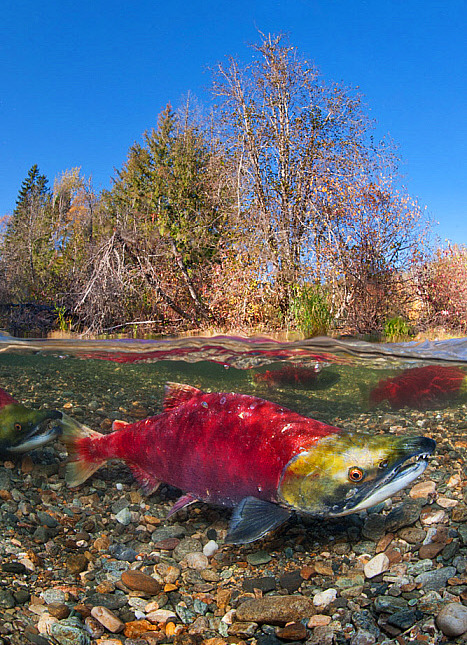

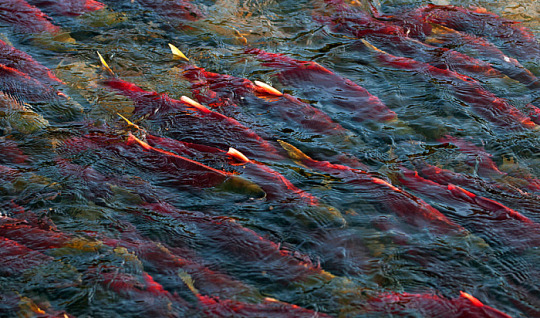
Male sockeye salmon (Oncorhynchus nerka) in Adams River, British Columbia
Photos by Alex Mustard
#Oncorhynchus nerka#Oncorhynchus#salmon#sockeye salmon#red#fish#red fish#male salmon#salmon river#adams river#river#river fish#british columbia#animals#wildlife#nature#breeding season
5K notes
·
View notes
Text

Portrait commission for @jabberwick.
#my art#artists on tumblr#red river hog#chinook salmon#might be just the best hybrid of all time#love this character
922 notes
·
View notes
Text
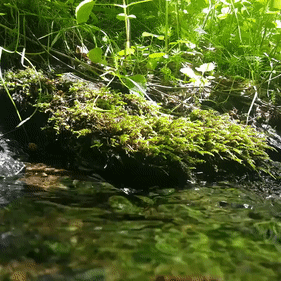
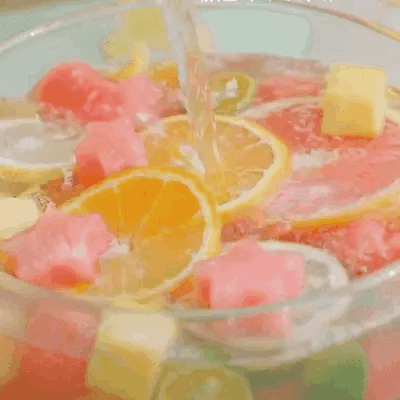
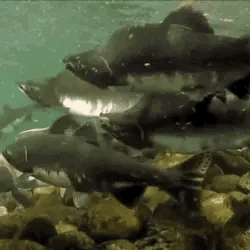
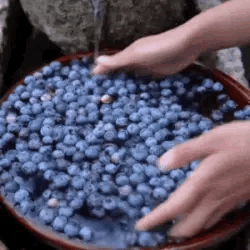
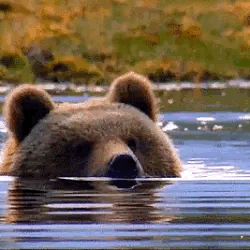
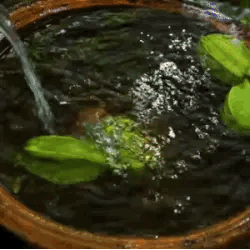
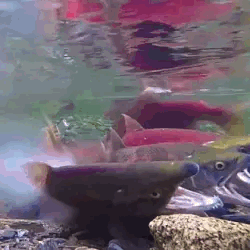

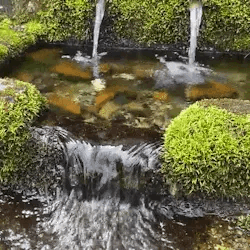

bear stimboard with fruits, fish and river related stims!
1 , 2 , 3 / 4 , 5 , 6 / 7 , 8 , 9
#nature stim#fish stim#river stim#fruit stim#multicolor#salmon stim#bear#bears#bear stim#orange stim#blueberries#blueberry stim#starfruit#stimboard#stim#stim blog#stim account#stims#stimblr#stim gif#gif#stimmy#visual stim#sfw agere
599 notes
·
View notes
Text
#art#animal#baby animals#animals#bears#big bears#grizzly bear#brown bear#salmon#eating#fishing#waterfall#river#mountains#trees#pond#lake#fyp#tumblr fyp#foryoupage#fyp2023#foryou#fypage#fypツ#fypシ
1K notes
·
View notes
Text
The Klamath River’s salmon population has declined due to myriad factors, but the biggest culprit is believed to be a series of dams built along the river from 1918 to 1962, cutting off fish migration routes.
Now, after decades of Indigenous advocacy, four of the structures are being demolished as part of the largest dam removal project in United States history. In November, crews finished removing the first of the four dams as part of a push to restore 644 kilometres (400 miles) of fish habitat.
“Dam removal is the largest single step that we can take to restore the Klamath River ecosystem,” [Barry McCovey, a member of the Yurok Tribe and director of tribal fisheries,] told Al Jazeera. “We’re going to see benefits to the ecosystem and then, in turn, to the fishery for decades and decades to come.” ...
A ‘watershed moment’
Four years later, [after a catastrophic fish die-off in 2002,] in 2006, the licence for the hydroelectric dams expired. That created an opportunity, according to Mark Bransom, CEO of the Klamath River Renewal Corporation (KRRC), a nonprofit founded to oversee the dam removals.
Standards for protecting fisheries had increased since the initial license was issued, and the utility company responsible for the dams faced a choice. It could either upgrade the dams at an economic loss or enter into a settlement agreement that would allow it to operate the dams until they could be demolished.
“A big driver was the economics — knowing that they would have to modify these facilities to bring them up to modern environmental standards,” Bransom explained. “And the economics just didn’t pencil out.”
The utility company chose the settlement. In 2016, the KRRC was created to work with the state governments of California and Oregon to demolish the dams.
Final approval for the deal came in 2022, in what Bransom remembers as a “watershed moment”.
Regulators at the Federal Energy Regulatory Commission (FERC) voted unanimously to tear down the dams, citing the benefit to the environment as well as to Indigenous tribes...
Tears of joy
Destruction of the first dam — the smallest, known as Copco 2 — began in June, with heavy machinery like excavators tearing down its concrete walls.
[Amy Cordalis, a Yurok Tribe member, fisherwoman and lawyer for the tribe,] was present for the start of the destruction. Bransom had invited her and fellow KRRC board members to visit the bend in the Klamath River where Copco 2 was being removed. She remembers taking his hand as they walked along a gravel ridge towards the water, a vein of blue nestled amid rolling hills.
“And then, there it was,” Cordalis said. “Or there it wasn’t. The dam was gone.”
For the first time in a century, water flowed freely through that area of the river. Cordalis felt like she was seeing her homelands restored.
Tears of joy began to roll down her cheeks. “I just cried so hard because it was so beautiful.”
The experience was also “profound” for Bransom. “It really was literally a jolt of energy that flowed through us,” he said, calling the visit “perhaps one of the most touching, most moving moments in my entire life”.
Demolition on Copco 2 was completed in November, with work starting on the other three dams. The entire project is scheduled to wrap in late 2024.
[A resilient river]
But experts like McCovey say major hurdles remain to restoring the river’s historic salmon population.
Climate change is warming the water. Wildfires and flash floods are contaminating the river with debris. And tiny particles from rubber vehicle tires are washing off roadways and into waterways, where their chemicals can kill fish within hours.
McCovey, however, is optimistic that the dam demolitions will help the river become more resilient.
“Dam removal is one of the best things we can do to help the Klamath basin be ready to handle climate change,” McCovey explained. He added that the river’s uninterrupted flow will also help flush out sediment and improve water quality.
The removal project is not the solution to all the river’s woes, but McCovey believes it’s a start — a step towards rebuilding the reciprocal relationship between the waterway and the Indigenous people who rely on it.
“We do a little bit of work, and then we start to see more salmon, and then maybe we get to eat more salmon, and that starts to help our people heal a little bit,” McCovey said. “And once we start healing, then we’re in a place where we can start to help the ecosystem a little bit more.”"
-via Al Jazeera, December 4, 2023
#indigenous#river#riverine#ecosystem#ecosystem restoration#klamath#klamath river#oregon#california#yurok#fishing#fisheries#nature is healing#literally this time lol#united states#dam removal#climate change#conservation#sustainability#salmon#salmon run#water quality#good news#hope#rewilding#ecology#environment
5K notes
·
View notes
Text
Three words: Dam removal WORKS.
In fact, it works immediately. The day after the dam removal on the Klamath River was completed, an effort spearheaded by the Yurok and other indigenous people of the area, salmon were seen swimming upstream past the old dam site. It didn't take years, or months, or even days. It took hours.
And now salmon can access plenty of historic habitat that was locked away for many years. This is a huge development, because habitat loss is the single biggest cause of species endangerment and extinction. Every time--every time--we restore a species' habitat, we give them a better chance to survive the multi-pronged environmental onslaught we've been subjecting them to.
Even if that habitat is imperfect, if it offers them food, shelter, and opportunities to safely reproduce. Nestled within an intricate network of relationships with other species that took thousands of years to develop, these salmon now have a better chance of weathering the years to come. Long live the salmon!
#salmon#dam removal#Klamath River#Yurok#landback#indigenous rights#nature#wildlife#animals#ecology#environment#science#conservation#scicomm#fish#fishblr#habitat restoration#restoration ecology#endangered species#extinction
366 notes
·
View notes
Note
May I have some Fae Killer dating headcanons?
Fae Killer is... weird
He's extremely hard to get a read on. At least the other Winter courtiers are easy to make sense of - Dust is quiet and serious, Horror is big and scary but shy, Nightmare is regal and refined with an undercurrent of rage. They make sense.
Killer? He's violent, but he's always got a friendly grin. He has the same "who, me?" expression whether he's eating a cookie or murdering someone. His backstory is unknown, changing every time someone asks. He appears to speak genuinely and openly, yet no one can trust a single word that comes out of his mouth. His knack for tricking and stealing is unparalleled, he tricks people out of things as small as their eye colour or as huge as their ability to breathe, all with the exact same 'silly' easygoing aura. He rescues stray cats from the cold and brings them into the castle, feeding them fish and chicken every day, but he also delights in torturing people he doesn't like.
Perhaps the only consistent thing about him is how obviously he's in love with you.
Even before dating him, his affection is blatant. He acts like he wants to be your best friend, your closest confidant, he's always looking for reassurance that he's your 'favourite'. The other skeletons will tell you that he doesn't shut up about you when you're not there. He's constantly outrageously flirting - he seems to show love through stealing from you, taking minor things like your ability to read the word 'strawberry', just so you'll get mad at him (it's obvious he thinks you're hot when you're mad). You're always covered in black marks and he laughs at almost everything you say.
When you do start dating him, he just... stops tricking you. Stops stealing from you, too. There's no warning, and no clear reason; you're just suddenly the only person in any world who's safe from his trickery. You could say something that leaves you wide open and the guy who could steal someone's nose from their face will act like he heard/saw nothing.
He's cuddly. So, so cuddly. It's actually kinda cute, when he's sleepy and aggressively snuggly with you. Kinda feels like he's been starved of affection, and he's making up for it by never letting you go.
No matter where you fall asleep, you'll wake up to Killer cuddled up. Probably a few of his cats piled in as well.
His number 1 goal is to get you laughing. There's always jokes, always remarks, it's so hard to be serious around him because he knows exactly what'll get you giggling. That's worth more to him than all the treasures in Summer and Winter.
He's generally an easygoing datemate, he has outlets for his jealousy. But he takes EXTREME offence to another fae stealing something from you. That means immediate violence.
This man will kill for you. In fact, he'll offer that option alarmingly quickly. Please ask him not to kill for you, for everyone else's safety.
His romantic side is dialled up to eleven. You're always coming home to mood lighting and surprise dinners, he's always taking you to beautiful scenic spots he's found in the Winter realm, he gives you things that remind him of you (typically flowers and gemstones, but sometimes magical artefacts, and occasionally something rather expensive that looks like it was stolen right from the Summer realm).
He's constantly wearing a 'happy' face. But sometimes, in private, the face falls. You can glimpse the part of himself he hides from everyone. If you can still hold him when he's not funny anymore, when the mask has fallen off... then he will burn down the whole world for you.
#llamagines#fae au#he and horror have a deal where whenever horror goes out on his outdoors adventures he brings some river salmon back for the cats#also i like to think that one of killers' cats doesnt like being touched#(killer respects that because hes a cat respecter)#but the cat absolutely loves you#im picturing a big fluffy old calico#killer is the 'want me to kill them for you?' meme for real
446 notes
·
View notes
